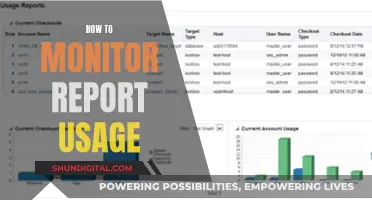
Monitoring sales staff performance is essential for any business to ensure that its employees are performing to a high standard and that the business is growing. While it is important not to micromanage, there are several ways to monitor staff performance, including regular reviews and one-on-ones, staff monitoring tools, and self-evaluation. This can help identify areas where employees need additional support and training, as well as keep track of the quantity, quality, and efficiency of work. Additionally, monitoring sales staff performance can help businesses evaluate the soundness of their operations and make better-informed decisions. This involves tracking various sales performance metrics and key performance indicators (KPIs) such as sales productivity, lead response time, opportunity win rate, average deal size, conversion rate, and customer acquisition cost.
| Characteristics | Values |
|---|---|
| Set goals and expectations | SMART framework |
| Choose the right metrics | Short- and long-term goals, sales KPIs |
| Coach your team | Provide tools and resources, regular feedback |
| Monitor sales data | Sales dashboards, CRM software |
| Review individual performance | Identify areas for improvement, provide support and training |
| Foster teamwork and collaboration | Encourage knowledge sharing, collective goal-setting |
| Ensure data accuracy | Utilise staff monitoring tools, e.g. epos card machine systems |
| Motivate and reward | Celebrate achievements, set realistic goals |
| Address performance issues | Identify root causes, provide solutions, reallocate resources |
| Focus on customer satisfaction | Measure customer satisfaction and retention rates |
| Competitor analysis | Monitor competitor pricing and strategies |
What You'll Learn

Set goals and expectations
Setting goals and expectations is a crucial aspect of monitoring and managing the performance of your sales staff. It provides a framework for evaluation and helps to ensure that your team is aligned with the broader objectives of the business. Here are some detailed guidelines on how to effectively set goals and expectations for your sales team:
Involve your team in goal-setting:
Encourage collaboration and buy-in by involving your sales team in the goal-setting process. Discuss the goals and expectations with your team and allow them to share their thoughts on what they consider important aspects of their work. This not only ensures that the goals are realistic and achievable but also motivates them to take ownership of the challenges they have helped set.
Set clear and specific goals:
Utilize a framework such as SMART (Specific, Measurable, Achievable, Realistic, and Time-based) to set effective goals. Define the goal and the strategies to achieve it, ensuring that it aligns with the organization's targets. Make sure the goals are measurable so that you can track progress and evaluate success.
Balance short-term and long-term goals:
Short-term goals, such as daily or weekly targets, help to keep your team focused and motivated. They provide a sense of satisfaction and achievement, even during the ups and downs of sales. However, it's important to balance these with longer-term goals, which offer a more realistic measure of success and give your salespeople room to breathe and strategize.
Establish sales productivity metrics:
Sales productivity metrics help leadership understand how much time reps spend on selling activities versus non-selling activities. By tracking these metrics, you can identify barriers and increase sales productivity. Examples of sales productivity metrics include CRM usage, calls made, emails sent, and sales tools usage.
Set sales quotas and track attainment:
Quota attainment is a critical metric that shows whether a sales rep has met their sales targets for a given period. It provides a clear indication of individual performance and helps sales leaders identify reps who may need additional support or coaching. Tracking quota attainment across the entire sales organization can also reveal the effectiveness of sales processes, messaging, and leadership.
Measure conversion rates:
Tracking conversion rates involves calculating the percentage of leads that ultimately become customers. This metric helps you evaluate the effectiveness of your sales team and identify areas for improvement. If your conversion rate is dropping, it may indicate issues with your sales process, team performance, or lead generation efforts.
Monitor lead response time:
The speed of response to leads is crucial. A quick response significantly increases the chances of qualifying a lead. Set expectations for lead response time and track this metric to ensure your team is following up on leads promptly and efficiently.
Analyze win rates:
Win rate refers to the percentage of final-stage prospects who become customers. Analyzing win rates provides insights into the effectiveness of your sales strategies and can help identify areas where additional training or skill development may be needed, such as negotiation skills or lead qualification.
Evaluate average deal size:
Tracking the average sales price or profitability of closed deals is essential. It helps identify whether reps are focusing on smaller, easier wins or if there is a need to reevaluate the sales opportunities in the pipeline. Monitoring average deal size over time helps adjust sales goals and strategies accordingly.
Provide regular feedback and recognition:
Regular feedback is essential to help your team stay on track and improve their performance. Meet with your team collectively and individually to discuss progress, share insights, and address any issues. Additionally, recognize and reward hard work and great performance to boost morale and motivate your team.
LCD vs IPS: Which Monitor is the Best Choice?
You may want to see also

Choose the right metrics
When monitoring the performance of your sales staff, it's important to choose the right metrics to help you make informed decisions about future strategy.
A mix of short- and long-term goals will help keep your sales team focused and enable them to track their progress towards their targets. Long-term goals keep their minds concentrated even during rough patches, while short-term daily or weekly goals provide satisfaction and motivation when long-term goals seem too far away.
- Sales productivity metrics: How much time do your reps spend selling? This is key for leadership to understand because time spent selling helps measure sales performance in terms of efficiency. Include metrics like CRM usage, calls made, emails sent, and conversations.
- Lead response time: The longer your lead response time, the lower your performance. If you respond to a lead within five minutes, you're 100 times more likely to qualify the prospect than if you wait a full 24 hours.
- Opportunity win rate: Win rate is the measurement of how many opportunities convert into closed-won deals. If the win rate is low or declining, it could be due to poor rapport building, lack of effectiveness with demo presentations, or poor negotiation skills.
- Average deal size: Tracking the average sales price or profitability from your closed deals can indicate whether reps are opting for smaller, easier wins, or if they are discounting average deals.
- Conversion rate: This measures the percentage of leads that ultimately become customers. It can help you calculate how many leads you need to make your revenue targets and indicate whether your reps are becoming more effective.
- Customer acquisition cost (CAC): This refers to the average sum of sales and marketing spend to convert a lead to a new customer. It's a reflection of the soundness of your sales and marketing strategies and how effectively both departments are leveraging resources.
- Sales volume by location: Monitoring sales volume by location (in-store or online) helps you understand where the demand for your product is highest and lowest.
- Sales cycle length: Analyzing sales cycle length for individual reps shows you how effective each rep is in comparison to their colleagues. However, a quick sales cycle might not always be good for business, as it may lead to dissatisfied customers.
Syncing Wireless Keyboards to Monitors: A Step-by-Step Guide
You may want to see also

Coach, don't micromanage
Micromanagement can be detrimental to your team's performance and success. Instead of selling, reps spend a lot of their time justifying their actions and reporting on progress. This management style can become toxic as it feels like a lack of trust in the team, causing morale to dip and staff turnover rates to increase.
So, how do you monitor your sales team's performance without micromanaging? Here are some tips to help you shift from manager to coach:
Set goals and expectations
Discuss goals and expectations with your team and allow them to have a say in what they believe are the most important aspects of their work. This will ensure that your team is working towards realistic expectations that they have approved themselves, and they will feel motivated to take on the challenges they have set for themselves.
Choose the right metrics
Select metrics that will help you make informed decisions about the future strategy for your sales team. Mix short- and long-term goals to keep your team focused and help them track their progress. Long-term goals keep their minds concentrated, while short-term goals bring satisfaction and motivation in the day-to-day.
Coach, don't micromanage
Provide the strategy, motivation, and tools your team needs to deliver a great performance, and then let them execute it. Give them the freedom to put your strategy into action without constant interference. Allowing your reps freedom and room for growth will create a positive working environment.
Use technology and tools
Utilize technology and tools like sales monitoring systems and project management software to track and optimize your team's performance. These tools can automate certain tasks, reducing the workload on your team and providing more accurate data for you to analyze.
Provide feedback and support
When discussing performance concerns, take a supportive and solutions-based approach. Find out why a task hasn't been completed instead of bluntly asking why. There could be technology issues, input needed from others, or external factors affecting their work. Being supportive shows you care about your team as people, and they will appreciate your efforts to help.
Remember, successful sales reps are often the byproduct of great coaching, not micromanaging. By following these tips, you can create a high-performing sales team that is motivated, engaged, and aligned with the company's goals.
Connecting an LCD Monitor to Raspberry Pi Directly
You may want to see also

Provide the right tools
Providing the right tools is essential for monitoring and improving your sales team's performance. Here are some ways to ensure your team has the necessary tools for success:
Access to Technology
Provide your sales team with access to the latest technology and software that can streamline their work and help them sell more effectively. This includes investing in a robust customer relationship management (CRM) system that is fit for purpose. A good CRM will enable your team to efficiently manage their customer interactions, sales pipeline, and sales data. Additionally, consider tools that can automate certain tasks, such as sending personalised emails when a deal moves along the pipeline, freeing up your sales team's time for more human-led activities.
Sales Dashboard
Implement a customised sales dashboard that provides real-time data and metrics, such as the number of leads, proposals, sales activities, and revenue forecasts. This allows your team to easily visualise their progress and identify areas for improvement. A dashboard can also help you, as a manager, to monitor the team's performance and quickly gain valuable insights to share with the team.
Data and Analytics
Ensure your sales team has access to relevant data and analytics that can inform their sales strategies. This includes data on sales volume by location, which can help identify where demand for your product is highest and lowest, and competitor pricing data, which can inform your pricing strategy. Additionally, provide your team with data on their own sales performance, such as sales cycle length and win rate, so they can identify areas where they need to improve and set realistic goals.
Training and Support
Provide ongoing training and support to your sales team to ensure they have the skills and knowledge to utilise the tools and technology effectively. This can include mentorship programmes, where more senior or experienced employees mentor new hires, as well as regular feedback sessions and performance reviews to identify areas where additional training may be beneficial.
Motivation and Recognition
Motivate your sales team by creating a positive work environment that fosters autonomy, commitment, and teamwork. Be transparent with sales data and performance metrics, and set up a sales dashboard that allows each team member to track their progress towards their goals. Celebrate achievements and recognise top performers to boost morale and motivate the team. You can also leverage friendly competitions and incentives to encourage your team to reach their targets.
By providing your sales team with the right tools and support, you can empower them to sell more effectively and ultimately drive the success of your business.
How Multiple Monitors Affect Gaming Performance
You may want to see also

Regular check-ins
Frequency and Consistency
It is important to have regular and consistent check-ins with your sales team. These can be done through individual meetings or group discussions. Forbes suggests that holding reviews every three months can lead to higher returns. It is recommended to hold recurring meetings on the same day and time each week or month so that team members can plan their time accordingly.
Open and Informal Conversations
Creating an informal and open environment during check-ins is crucial. Encourage a two-way dialogue where team members feel comfortable discussing any topics. This can be achieved by asking open-ended questions such as:
- How is everything going?
- Is there anything on your mind?
- How confident do you feel in carrying out your duties?
- Are there any areas where you would like more training or support?
It is also important to create a safe space for employees to provide feedback, suggestions, or share their goals.
Troubleshooting and Problem-Solving
Use the check-ins as an opportunity to collectively troubleshoot solutions and share helpful workarounds. Encourage team members to learn from each other by sharing their successes and challenges. This can be facilitated by providing a recurring agenda as a template, so team members know what to expect and can come prepared with relevant information.
Individual Performance Reviews
In addition to group discussions, it is essential to have one-on-one check-ins with each team member. These meetings can be used to discuss any external factors impacting their performance and create a plan to help them improve. It is also an opportunity to offer tailored support, training, or resources to proactively address any challenges they may be facing.
Employee Satisfaction and Wellbeing
Monitoring employee satisfaction and wellbeing is critical. Work-related stress has been identified as a significant health issue, and ensuring your employees' wellbeing is essential for both their individual performance and the success of your business. One way to gauge employee satisfaction is through feedback, such as asking employees to rank their job satisfaction on a scale and following up with qualifying questions.
Mentorship and Support
Consider assigning a senior or long-standing employee as a mentor to new hires. Mentors can pass on their knowledge, train new team members, and monitor their progress and performance. This can be especially useful if you, as a business owner, do not have the time to monitor the performance of all staff members while also running the business.
Performance Data and Action Steps
By following the steps above, you will gather valuable performance data. To improve staff performance, it is essential to:
- Identify the root cause of any issues.
- Provide solutions, such as additional training or support.
- Offer consistent feedback, both positive and constructive, to boost morale and satisfaction.
- Set realistic goals based on the performance data.
- Recognize and reward hard work to motivate and engage your team.
- Address long-term performance issues if initial interventions are ineffective.
Ankle Monitor Removal: Difficult, but Possible
You may want to see also
Frequently asked questions
Monitoring sales staff performance helps businesses identify areas for improvement and fuel future growth. It also helps to identify areas where employees need additional support and training, boosting morale and improving customer satisfaction.
There are several ways to monitor sales staff performance, including regular reviews and one-on-one meetings, using staff monitoring tools, tracking key performance indicators (KPIs), and analysing sales data.
Some important KPIs for sales staff include revenue by representative, customer retention rate, average purchase amount per deal, and close rate.
By tracking KPIs and analysing sales data, organizations can identify trends, make more effective plans, and improve their sales strategy. Monitoring sales performance also helps organizations make informed decisions about staffing needs, training programs, and business development.
One challenge is finding the right balance between trusting your staff and verifying their performance. Another consideration is maintaining employee trust and transparency when monitoring their activities. It's important to comply with data protection regulations and be transparent with employees about what is being monitored and how often.







